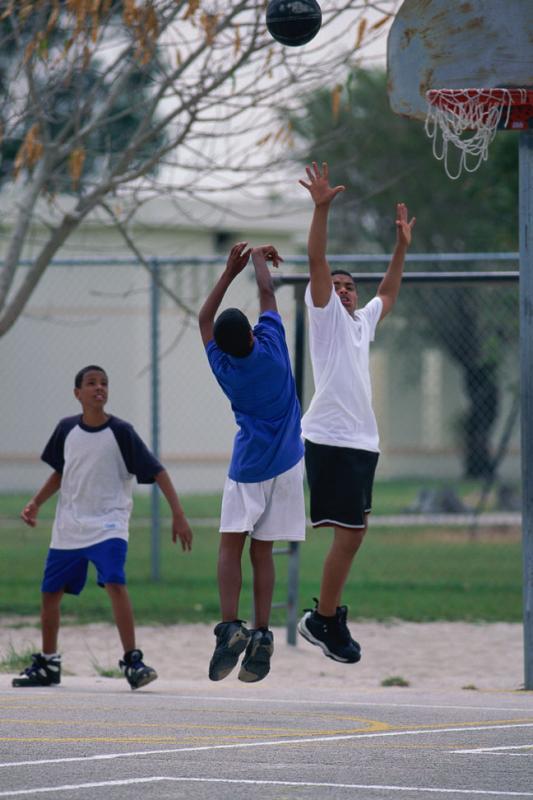

Are athletes whose families can afford the high cost of today's increasingly specialized and expensive youth sports paying another price - in higher rates of injury?
The answer appears to be yes.
New research presented at the International Olympic Committee World Conference on Prevention of Injury & Illness in Sport in Monaco in April 2014 for the first time links overuse injury rates in young athletes with their socioeconomic status.
Researchers at Loyola University Medical Center found that the rate of serious overuse injuries in athletes who come from families that can afford private insurance is a whopping 68 percent higher than the rate for lower-income athletes whose families have public insurance (Medicaid).
The findings are the latest to be reported as part of Loyola's 3-year study of overuse injuries and sports specialization. The link between sports specialization and overuse injuries had been previously reported, but until now the link to socioeconomic status had not been identified.

Qualifying an athlete as highly specialized if they answered Yes to three questions (Do you have a main sport? Have you quit all other sports to focus on one sport? and Do you spend more than eight months per year training and competing in a single sport?), Neeru Jayanthi, MD, and his Loyola colleagues also found that privately-insured young athletes were twice as likely as publicly-insured athletes to be highly specialized in one sport.
"Intense specialization in one sport can cost thousands of dollars a year in equipment, fees, transportation, private lessons, etc.," said Jayanthi in presenting his findings in Monaco. "Having the financial resources to afford such costs may provide increased opportunities for young athletes to participate in a single sport."
But along with the increased cost to their families, such athletes may be paying a personal price, added Lara Dugas, PhD, MPH, co-investigator on the study. "Young athletes with this type of training appear to be at greater risk for serious overuse injuries than those who have fewer financial resources," Dugas said.
The findings reported by Jayanthi are just the latest in an ongoing collaborative study of athletes ages 7-18 seen at primary care and sports medicine clinics at Loyola University Health System and the Ann & Robert H. Lurie Children's Hospital of Chicago.
Researchers so far have enrolled 1,190 athletes in the study, including 1,121 for whom insurance status could be determined. Both institutions care for a socioeconomically diverse population represented in the study. The median income of the families of the young athletes was approximately $70,000; approximately 11 percent came from low-income neighborhoods, while 19 percent are on public aid.
Athletes completed surveys reporting training volumes (e.g. the amount of activity in a single training session), age of engagement in competitive sports, degree of specialization, etc. Researchers found that 30 percent of privately insured athletes were highly specialized in one sport (see box at right), compared with 18 percent of athletes who were publically insured. Thirteen percent of the privately insured athletes suffered serious overuse injuries, compared with 8 percent of publicly insured athletes.
The study also found that both publicly and privately insured athletes spent about 10 hours per week in organized sports. But there was a significant difference in the amount of time they spent in free play: 7.1 hours per week for publicly insured athletes, versus 5.2 hours per week for privately-insured athletes.
Free play includes unstructured activity such as pick-up basketball games and touch football. From this finding, researchers postulate that more unstructured free play may help protect athletes against serious overuse injuries, a hypothesis they hope to confirm with further study.
Previous research has identified numerous other advantages to such unstructured free play, with the American Academy of Pediatrics emphasizing in a 2007 report that "play (or some available free time in the case of older children and adolescents) is essential to the cognitive, physical, social and emotional well-being of children and youth," and that organized sports participation should not come at the expense of such play.
Serious overuse injuries can force young athletes to the sidelines for one to six months or longer. Such injuries include stress fractures in the back, leg, ankle, foot, knee, shoulder/arm, elbows or wrist, elbow ligament injuries and osteochondral injuries (injuries to cartilage and underlying bone) (DiFiori, 2014)
To reduce the risk of such overuse injuries, Jayanthi recommends that youth athletes:
 per week in organized tennis and 4.3 hours in unstructured free play. A good rule of thumb, says Jayanthi, is not to spend more than twice as much time playing organized sports as spent in unstructured play.
per week in organized tennis and 4.3 hours in unstructured free play. A good rule of thumb, says Jayanthi, is not to spend more than twice as much time playing organized sports as spent in unstructured play. Jayanthi expressed frustration that the message about the link between overuse injuries and sport specialization did not appear to be getting through to parents. It is "hard to tell parents the truth: that there is a genetic limit to what an athlete can become, no matter how much they train," he said.
For additional tips on how parents can help reduce the risk that their youth athlete will suffer an overuse injury, click here [3].
For more about the reasons against early specialization, click here [4].
Sources:
DiFiori JP, Benjamin HJ, Brenner J, Gregory A, Jayanthi N, Landry GL, Luke A. Overuse Injuries and Burnout in Youth Sports: A Position Statement from the American Medical Society for Sports Medicine. Clin J Sports Med.2014;24(1):3-20.
Ginsburg KR, Committee on Communications, and the Committee on Psychosocial Aspects of Child and Family Health. The Importance of Play in Promoting Healthy Child Development and Maintaining Strong Parent-Child Bonds. Pediatrics. 2007; 119(1):182-191
Jayanthi N. Injury risks of sport specialization and training in junior tennis players: a clinical study. Paper presented to the Society for Tennis and Medicine Science North American Regional Conference, Atlanta GA. December 2012.
Rose MS, Emery CA, Meeuwisse WH. Sociodemographic predictors of sports injury in adolescents. Med Sci Sports Exerc. 2008;40:444-450.

Links:
[1] https://momsteam.com/successful-parenting/unstructured-free-play-important-for-child-development-experts-say
[2] https://momsteam.com/successful-parenting/delay-sport-specialization-until-late-adolescence-experts-say
[3] https://momsteam.com/safe-kids-worldwide/preventing-overuse-injuries-overtraining-burnout-9-ways-parents-can-help
[4] https://momsteam.com/successful-parenting/early-specialization-in-youth-sports-supported-by-myths-and-competitive-culture-not-facts
[5] https://momsteam.com/health-safety/overuse-injuries-burnout-in-youth-sports-what-we-know-what-we-dont
[6] https://momsteam.com/successful-parenting/parenting-elite-athletes/specialization/early-travel-team-play-fosters-elitism
[7] https://momsteam.com/health-safety/timing-of-acl-surgery-in-children-teens-function-insurance-coverage-household-income
[8] https://momsteam.com/successful-parenting/parents-need-to-resist-pressure-from-coaches-for-early-specialization